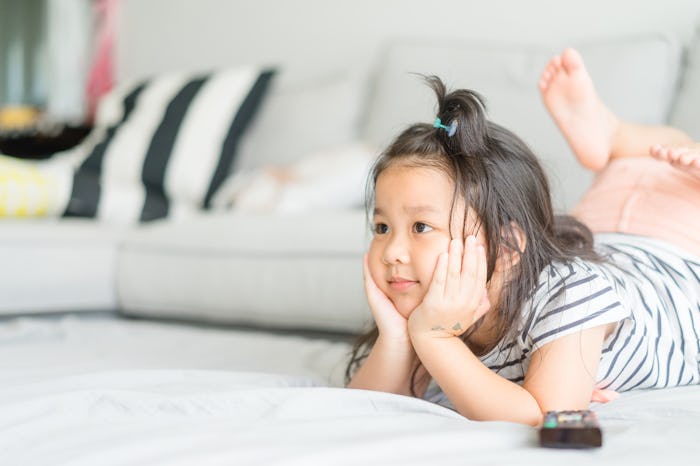Life

"Passive Screen Time" Might Not Be As Bad As It Sounds, Depending On The Details
In my house, the TV is on pretty much all day long. Already, I can hear the virtual slap-slap on the wrists from the mommy shamers: “Haven’t you heard of passive screen time and the damage it can do?” Well, yes, yes, I have.
Chances are, you've probably experienced passive screen time, too, and not even realized it. It's defined as "when a child passively consumes digital content with no thought, creativity or interaction required to progress," reported EdSurge, an educational news organization. It might be putting the TV on so your baby watches a program while sitting in his playpen. Or it might be your toddler thumbing through your phone. Essentially, it's consuming screen time without any additional educational instruction by a parent or a caregiver.
I, for one, have been guilty of allowing passive screen time, but only to a point. Sure, the TV is on, but it’s not like I plunk my kids down in front of it as soon as they open their eyes and say, “Have at it, kiddos.” They’re not left to their own devices while I do my nails or gab on the phone. The TV is NOT a babysitter, nor should it act as one. For us, the TV is more like background noise. And heck, who hasn't just zoned out in front of a TV from time to time? Personally, it has gotten me through many, many a midnight marathon breastfeeding session.
Honestly, my kids sometimes sit down for a bit and watch TV, but mostly we’re playing or doing crafts or something else. I mean, if you have small children, you know that they have the attention span of a gnat, so the thought that I’d be damaging their brains by having the TV on and them glued to it for hours on end is, frankly, asinine.
Even the American Academy of Pediatrics (AAP) pointed out that media usage isn’t all that bad. “When used thoughtfully and appropriately, media can enhance daily life,” the AAP reported on its site. “But when used inappropriately or without thought, media can displace many important activities such as face-to-face interaction, family-time, outdoor-play, exercise, unplugged downtime and sleep.” And that’s where concerns over passive screen time comes into play.
The World Health Organization echoed the same sentiments. It also stated that children, especially those 2 or under, should not have sedentary screen time, which is where a child is not actively engaged in the media content she is consuming.
What’s important to keep in mind is that these are all recommendations and guidelines. There are no hard and fast rules about how, when, (and specifically, how much) your child should watch. Ultimately, it’s up to you as a parent to determine what kind of TV- or video-watching your child does. Obviously, nothing can replace that parent-child interaction. "While parents should be rightfully concerned about the amount of time their young kids spend in front of screens, there's a lot of great content out there that can help kids learn valuable lessons," Jill Murphy, Editor-in-Chief of Common Sense Media, tells Romper. "Enjoying a show and discussing it together helps kids better understand and absorb those lessons. Preschoolers will soak up whatever they see and hear, so look for media with positive role models, messages about sharing and being a good friend, and managing feelings."
But still, there’s something to be said for passive screen time, and it’s important to hear all sides. If you’re going to have your little one watch Sesame Street, make sure that you watch it together, and try to make it educational. Explain that Elmo is the color red, or count along with Count von Count, and help your little one learn her numbers. Or you might even talk about all the animals he sees in Daniel Tiger’s Neighborhood. The point is, passive screen time can become active if you participate with your child, and it can be turned into an educational experience, as well as some bonding/cuddling time with your baby. Unsure of how to introduce the tube to your toddler? You can check out some of Common Sense Media’s top recommended shows for toddlers.
So sure, there are going to be times when you need to call a plumber because your pipe just burst and you might turn on the TV to keep your child occupied for a few precious minutes. And in those times, when it’s limited, it’s cool for your wee one to watch TV. Just make sure to not make it too much of a habit of unsupervised screen time.
After all, there is so much quality and educational programming on TV that to say that television is totally bad is a disservice. There might be some days when your child watches more TV than others, and ultimately, it's all okay. Just be aware of how much TV your child watches, and be sure to balance it with other activities that stimulate her both mentally and physically.
This article was originally published on